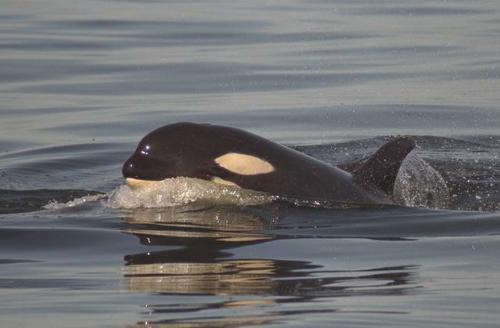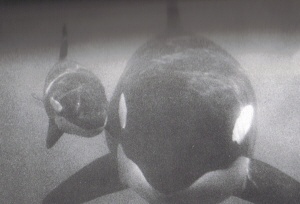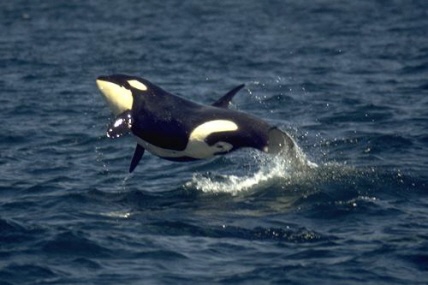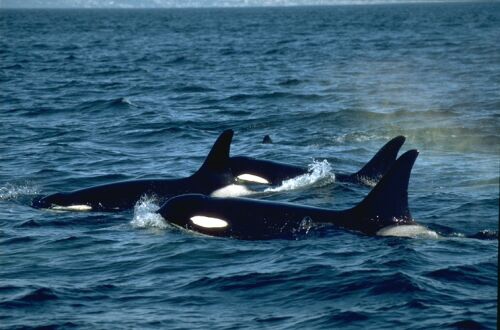

Orcas live a long time. In fact, their lifespans are pretty much the same as ours. Their lives progress at pretty much the same rate, too-they mature around the same age and become post-reproductive at around the same time.
An Average Orca's Life
Let's investigate the life of an average orca.
Of course it all begins at birth. Calves are usually born tail-first, but can be born either way. The birth is usually assisted by family members. Inside the womb, the calf will have heard the family voices for many months, and feels comfortable with them. Typically, an 'auntie' will assist the calf to the surface for its first breath. The calf is usually around 2.5 metres long and weighs about 200 kg.
The calf instantly knows how to swim, despite the fact that its a little out of control. The mother slows it down and teaches it to stay in control. This calf, a female, figures out how to nurse because she is attracted the the mother's white patches.
This is a very strong instinct, and it is what keeps the calf alive. Sometimes, however, (usually in captivity) it doesn't work so well.

Back to our wild-born calf. As she grows, she will play with her sisters and brothers and mother. She will nurse from her mother for at least a year, and will follow the pod tucked beside her mother learning all the nooks and crannies along the coast. While she grows, she will learn her pod's dialect, a very serious undertaking. She will learn to spyhop and breach.

Once she reaches around a year, the calf will probably stop nursing and begin to learn to hunt salmon. She'll also learn to tell the different pods from each other by their voices, and during the summer she will meet the other pods during the exciting summertime reunions. Then she'll meet the other calves, for her to play with. She'll also learn, of course, to tell apart the transients, and to ignore them.
Around the time our calf is 3-5 years old, her mother will have another calf, a playmate. Our calf (let's call her Lilly) has a new brother to play with, but now Lilly isn't the baby anymore. While her mother still pays attention to her, she's now become a juvenile instead of a calf.



Lifespans and Reasons for Death
Orcas are born, usually tail-first, at about 2.5 metres in length and 200 kg in weight. Sometimes orcas are born head-first, but often this indicates problems with the pregnancy. Females mature at about 14-15 years of age, which is around when they have their first calf. Occasionally younger orcas have calves-once an orca was recorded having a calf at age 11. Orcas mate with whales from other pods. That's one of the uses of the different dialects-the more different the dialect, the more distantly related the whale is. This makes it easy to avoid inbreeding; the orcas try to mate with the farthest related whale possible. After a 16-17 month time of pregnancy, the orca calf is born.
Females typically have 4-6 calves over their lives, then become post-reproductive around 40-50 years of age. They can live for many more years. The typical lifespan of a female is around 50 years, but many live into their 80s...some even into their 90s!
Males mature around 12-14 years of age. At that point, they start to grow extremely fast. Their fin begins to grow so fast, it is wobbly and awkward. Males with fins growing at this rate are called 'spouters' and are easily identified by their wobbling fins. Around 20 years of age, they are fully grown. The males have less of a lifespan than females, the typical age of death being 29. However, many males live into their 40s, 50s, and even 60s.
When a wild orca dies, it typically just disappears. When it doesn't show up with its family, researchers begin to suspect a death. After it is missing for about a year, it is officially declared dead. But because they just go missing (the length of the BC study, only about 11 whales have been recovered), we don't really know what they died of.
Obviously, some die of old age. This is probably what happened to Eve (A9), who washed up on a beach. They never figured out what happened to her, but it might've been old age.
Kelkpa (A57), a five year old who was discovered ill, and then dead, died of erysipelas, a bacterial infection. Infections may be the cause of many non-age-related deaths.
Everett (J18), washed ashore in Boundary Bay. He had died of a severe bacterial infection called Edwardsiella tarda
What may be becoming a major cause of death is PCBs, contaminents which are building at an alarming rate in orcas. Transient orcas, who have the most PCBs, are now the most contaminated marine mammals on earth.
Other, less usual reasons for death can include gunshot (that was quite frequent before the capture era; now it probably hardly ever happens), run-ins with propellers (though the survival rate for this seems to be high), and strandings. Strandings are relatively rare in orcas, though a few mass strandings have been recorded. A few transients have stranded and died after chasing harbour seals and going too shallow.

Calves have the highest mortality rate of all the ages. No one understands why, but about 40% of resident calves die within their first year. And these are the calves we find out about before they die. There are probably more, that we never see. Who knows why they die so often? The orca adoptive programs no longer name whales until they have passed 1 or 2 years of age, depending on the organization, because there is such a high risk.
In captivity, we know much more about deaths. For wild-captured whales, occasionally it was diseases they contacted in the wild. An often cause of death is pneumonia, which was what killed Keiko, the famous whale star of Free Willy. Bacterial infections, tumours, many things can cause an orca's death.
Just like in the wild, calves have a very high mortality rate in captivity. Miscarriages and still-births happen far too often. In fact, around half of captive-born orcas don't survive birth. Until 1985, no orca born in captivity had lived over a year. 9 orcas were born in captivity before then; the longest-lived one was 46 days old at time of birth. Since 1961, the first orca capture, aorund 35 calves have been born (or miscarriaged) and not survived their first year. Why do orca calves die so easily? No one knows. A frequent cause of captive death is a refusal to nurse, and therefore starvation. Some have brain problems; many mothers simply can't take care of them. And this is not a bashing of captive breeding, either; some orcas in captivity are wonderful mothers, like Kasatka, successful mother of three, and Katina, successful mother of four living calves. But some aren't.
It may be a long time before we know the reasons behind most orca deaths; its hard to tell since they sink. Yet another one of the mysteries that still needs unraveling, surrounding these mysterious creatures.